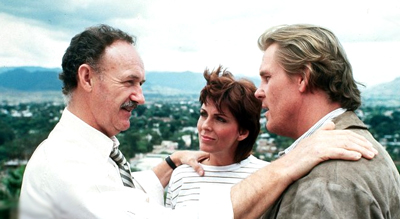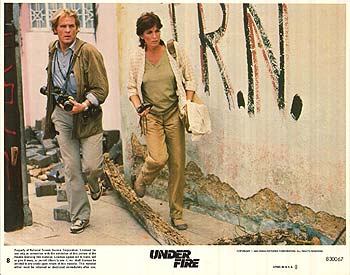Under Fire
For this class we watched multiple films but one of the films I will be focusing on for this post is Under Fire. It was a really great captivating movie. Although interestingly enough it did not actually happen in real life, but if it was something that I would have watched without knowing that, I would have believed it to have been true. Below is background information on the movie and the main points/themes throughout it. I worked on this presentation with my group and I have provided a powerpoint presentation link below if you wish to look at more pictures or video clips!
Link -- Under Fire
Movie Overview
- Made in 1983
- Setting is 1979 Nicaragua, near the end of the Somoza dictatorship
- Follows the adventures of 3 Americans
- Russell Price (main character, photojournalist)
- Alex Grazier (aspiring anchorman)
- Claire (reporter)
- Events of movie entirely fictional, but set within accurate historical context
- Inspired by the actual murder of an American journalist, Bill Stewart
Historical Context
- Somoza dictatorship (1936-1979): ruled Nicaragua, had control of National Guard
- Supported by US via shipments of arms, money, etc. (until 1977)
- Opposing rebels: Sandinista National Liberation Front
- In movie, frequently reference the charismatic Sandinista leader “Rafael,” who is fictional but likely based on Carlos Fonseca Amador
Plot Overview
- Russell supposedly only there to take pictures/document the war
- This brings him & friends into close contact with rebels (Sandinistas) and also Somoza soldiers
- Eventually Americans lose their objectivity, and become emotionally supportive of the rebel cause
- This leads Russell to make a crucial choice
- Sandinista rebel leader KIA, risking loss of morale and a fizzling out of revolution
- Russell agrees to take a false picture of rebel leader that makes it appear as if he’s still alive
Character Development: Sympathy for Sandinista Rebels
- All characters initially viewed Nicaragua as a “neat little war, a nice little country” that was a prime spot for great news headlines
- Key moment that makes Russell begin to sympathize with rebels
- Russell befriends group of rebels, one of which is shot by Somoza soldiers in front of him
- Russell and friends later see rebels (families, women, children) living in camps, and realizes their humanity
- Later come to see that Nicaraguans are honest people worthy of compassion
- Realization only comes after their own American friend Alex is shot in cold blood by Somoza soldiers → came to understand that Nicaraguans suffer death of friends/family daily
War: From the Perspective of the Nicaraguans
A Country Divided:
“You are sentimental as shit. You fall in love with the poets. The poets fall in love with the Marxists. The Marxists fall in love with themselves. The country is destroyed with rhetoric. And in the end we are stuck with tyrants. Somoza, he’s a tyrant for sure, but thankfully he’s not a poet, you see. If we wish to survive, then we must pick from a choice of tyrants. You poets chose the wrong side.”
Rafael: Leader, Symbol & Undying Spirit of the Revolution
The revolution centers around the charismatic Sandinista leader “Rafael,” who is fictional but likely based on Carlos Fonseca Amador, founder of FSLN
The Importance of Murals
- a form of protest
- signify the spread of the revolution
- using art as a convergence of politics, identity, and solidarity
Despite US government’s involvement support of Somoza, US cultural references are still evident in lives of Nicaraguans
War: From the perspective of the US
The Thrill-Seeking American Mercenary:
- “Welcome to Somoza’s meat market”
The Initial Ignorance of Western media
- “He said the nightclub bombing wasn’t big enough to cover in the world section…”
- “What’s he got better than that? He’s got the pope in Egypt”
- “Forget the pope, Charlie, you got the pope somewhere every week. You got a big story here, it’s the first sign of fighting in Managua”. Get a map Charlie, look up Nicaragua: you go to New Orleans and then you turn left.”
Political Immunity for Journalists
- Journalists are seen as impartial documentors of the war
- initially when Price shouts periodista, the military leave him alone.
- Prensa is also a form of protection
- “They should have killed an American journalist 15 years ago.”


